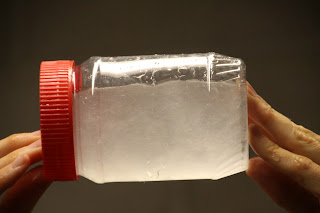[I've taken classes at MCBA before: binding to letterpress to platen press to layout. I've decided to restart, with the idea of a core certificate in mind. Maybe one day a mentorship. Right now, their poet is my girl M.]
These twin mounds of cotton remind me of lungs. So soft, like little lambs. Sarah passes them around: abaca, flax, cotton, papers made at various lengths of beater times.
We apron. We rubber boot. I fantasize about Wellies. I think of puddles and yellow ducks.
We watch the abaca get beat. An open-top funnel. A fiber in rotational pull.
We learn the discarded has a home here: peanut butter jars let us examine the density of fiber. She holds it to the light and the abaca worms there.
What makes a good fiber? Cotton, linen, bamboo. Sarah tells us of how she blistered her fingers cutting jeans into appropriate pieces. These are pancakes. I will show you three more.
What does not make a good fiber? Wool. Wool, when agitated, becomes felt. It does not sift but binds to itself. Plants can be integrated. Cellulose is key.
The pulp must be pinched slowly, dropped into the water. One pound of dry weight; add water to the fill line. (Imagine it.) Drain with a bucket and strainer.
The yogurt cup is another essential throw-away. Scoop two cups slurry into the vat. Stir with your hands. Reminds you of: high school art class, pottery unit. (I couldn't keep my hands out of the ice cream pails of slip.) All night, you could trail your hands in this water.
There is the mould and the deckle. One sweeps the matching components into the slurry, into the vat, and shimmies, as if panning for gold. I twitch; my hands stutter. My paper is smoother, the twitchier I get. I shake before rising. I learn the warp of the mould can crumple the paper on the felt. I learn to not shift so violently, or the paper can warp on the mould. I envy the mistakes of my classmates--the hills that are declared cells, the lines that resemble veins. I think of my (in)fertility poems, my patient-on-an-examining-table poems, my definition-of-a-cyst poems. I would press them right next to those throbbing, pulsing failures.
The paper loses its shine as it dries. Here it is: wettest in its form. I cannot help but make, over and over, the smaller size, the one that is closest to the trade paperback. Others make the larger sheets, varying according to whim. I am looking ahead, though to what, I do not know.
There is also pigmentation. Sarah tests the water; the water should run clear when the dye has been absorbed (one uses the slippery retention agent for aid), but this dye is the pigment of her pigment. Declared close enough, the cotton is called: salmon, dusty rose, insulation-pink. I add: tangerine. I think of palms.
The paper is pressed, boards and water. And after all of this, the best system, besides the drying racks or the window pressings, is the restraint dryer, which is little more than corrugated cardboard, blotters, and a linted fan.
They are there, sleeping. Peeled away from felt. In the basement of the center for book arts, the security guard leaning over a newspaper. Traffic has slowed outside; the sun is setting earlier and earlier every day. Equinox has passed.
I promised three pancakes. And there they are, free for students to slurry again. Blue cotton, red cotton, white abaca. Patriotic.
Linger at the installation. Think of the moon. Your thoughts will batter tonight; you've been energized.
{ cross posted on paper tattoo press }





















1 comment:
This is the most beautiful rendition of paper making I have ever seen.
Thank you.
Post a Comment